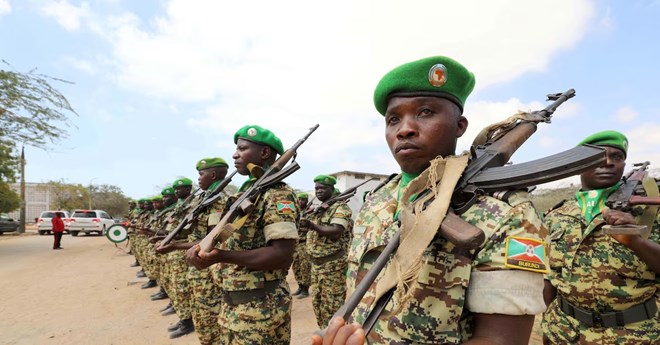
Wednesday December 11, 2024

Burundian African Union Mission in Somalia (AMISOM) peacekeepers stand in formation during a ceremony as they prepare to leave the Jaale Siad Military academy after being replaced by the Somali military in Mogadishu, Somalia. February 28, 2019. REUTERS/Feisal Omar/File Photo
Mogadishu (HOL) — The African Union Transition Mission in Somalia (ATMIS) will officially conclude its 17-year operation at the end of December, raising fears of a potential resurgence by the militant group al-Shabaab. The forthcoming African Union Stabilization and Support Mission in Somalia (AUSSOM) is set to replace ATMIS, but analysts warn that the new force may struggle to counter al-Shabaab’s entrenched influence and growing strength.
According to Colin Robinson, a Lecturer at the Centre for Defence Leadership and Management at Cranfield Defence & Security in Shrivenham, the transition from ATMIS to AUSSOM could leave Somalia vulnerable to a significant resurgence of al-Shabaab.
ATMIS has played a role in Somalia’s fragile security framework, yet unfulfilled goals and persistent instability mar its legacy. The mission’s liberal peacebuilding approach, emphasizing democratic governance and institutional development, has often clashed with Somalia’s deeply entrenched clan dynamics and history of conflict. Al-Shabaab, exploiting these systemic weaknesses, has managed to sustain its shadow governance and attract local support.
Since its inception in 2007 as AMISOM, the AU mission has engaged in gruelling counterinsurgency battles, including the four-year urban warfare campaign in Mogadishu. Despite securing some key towns, the mission’s reach has been stretched thin across Somalia’s vast southern region. Isolated bases like Bulo Mareer have come under devastating attacks, highlighting vulnerabilities in ATMIS’s operational strategy.
Creating a unified Somali National Army (SNA) to replace foreign forces has been a longstanding goal. However, clan loyalties and political divisions have hindered progress, leaving the SNA as a patchwork of militias and foreign-trained brigades. Efforts by the U.S. and Turkey to develop elite units such as Danab and Gorgor have achieved some success, but these forces remain heavily dependent on external funding and expertise.
AUSSOM, expected to deploy 11,900 personnel, will inherit many of ATMIS’s challenges. The transition will see a modest reduction from ATMIS’s 12,626 troops, with Uganda continuing its leading role. Additionally, Somalia’s defence pact with Egypt may bring up to 5,000 Egyptian soldiers to the region. However, Egypt’s lacklustre counterinsurgency record raises questions about its effectiveness in this context.
Political discord within Somalia’s Federal Government and Federal Member States further complicates efforts to unify against al-Shabaab. Regional tensions between Ethiopia and Egypt over the Grand Ethiopian Renaissance Dam exacerbate these divisions, undermining the cohesive action needed to combat the insurgency.
Al-Shabaab’s ability to adapt and endure has kept it at the forefront of Somalia’s security crisis. Its taxation network and governance structures remain robust, allowing it to operate as a shadow state. Analysts warn that with ATMIS’s withdrawal, al-Shabaab could intensify efforts to seize urban areas, including Mogadishu, challenging the weakened government forces.
President Hassan Sheikh Mohamud’s declaration of “total war” against al-Shabaab in 2022 has intensified military campaigns, but the group’s unity and resolve often surpass that of its adversaries. Calls for negotiation with the insurgents persist among international donors, yet such talks remain unlikely under the current administration.
Somalia’s future hinges on resolving deep-seated political fractures and strengthening its security forces. Without significant reforms, AUSSOM’s limited resources may only delay a potential collapse of government-controlled areas. Robinson believes that a scenario where al-Shabaab dominates southern Somalia or forces international troops to retreat to fortified positions in Mogadishu is increasingly plausible, drawing grim parallels to Afghanistan and Iraq.